
An oak is a hardwood tree or shrub in the genus Quercus of the beech family. They have spirally arranged leaves, often with lobed edges, and a nut called an acorn, borne in a cup. The genus is widely distributed in the Northern Hemisphere; it includes some 500 species, both deciduous and evergreen. Fossil oaks date back to the Middle Eocene. Molecular phylogeny shows that the genus is divided into Old World and New World clades, but many oak species hybridise freely, making the genus's history difficult to resolve.
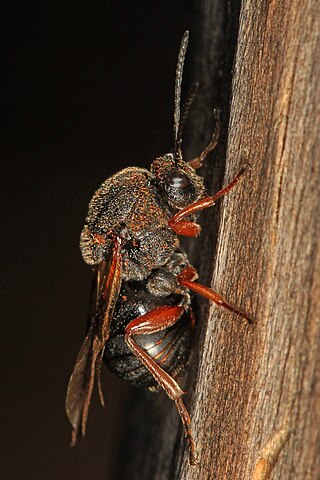
Gall wasps, also traditionally calledgallflies, are hymenopterans of the family Cynipidae in the wasp superfamily Cynipoidea. Their common name comes from the galls they induce on plants for larval development. About 1,300 species of this generally very small creature are known worldwide, with about 360 species of 36 different genera in Europe and some 800 species in North America.
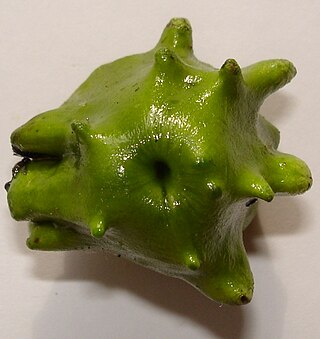
Andricus quercuscalicis is a gall wasp species inducing knopper galls.

Andricus kollari, also known as the marble gall wasp, is a parthenogenetic species of wasp which causes the formation of marble galls on oak trees. Synonyms for the species include Cynips kollari, Andricus quercusgemmae, A. minor, A. indigenus and A. circulans.

Andricus grossulariae is a gall wasp species inducing agamic acorn cup galls on oak tree acorn cups and sexual phase galls on catkins. Synonyms include Andricus fructuum, Andricus gemellus, Andricus intermedius, Andricus mayri and Cynips panteli.

Cynipini is a tribe of gall wasps. These insects induce galls in plants of the beech and oak family, Fagaceae. They are known commonly as the oak gall wasps. It is the largest cynipid tribe, with about 936 to 1000 recognized species, most of which are associated with oaks. The tribe is mainly native to the Holarctic. Cynipini wasps can act as ecosystem engineers. Their galls can become hosts of inquilines, and the wasps themselves are hosts to parasitoids.
Bassettia is a genus of gall wasps found in North America.

Callirhytis is a genus of gall wasps in the family Cynipidae. There are more than 90 described species in Callirhytis. Wasps in this genus primarily induce wasps on oak trees in North America.
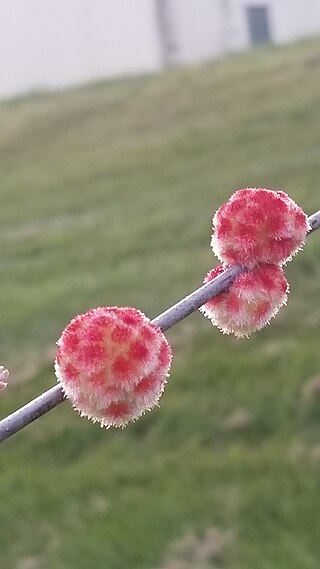
Callirhytis seminator, the wool sower, is a species of gall wasp in the family Cynipidae.

Callirhytis quercussuttoni, the gouty stem gall wasp, is a species of gall wasp. Its galls appear on oaks in the red oak group on the west coast of North America.

Melikaiella flora, formerly Callirhytis milleri, the live oak petiole gall wasp, is a species of hymenopteran that produces leaf galls on coast live oak, interior live oak, and canyon live oak trees in California in North America. The gall often subsumes the entire petiole and occasionally part of the leaf body. Pregnant females of the second generation oviposit on acorns; these acorns are usually dropped by the tree and become food for squirrels, deer, Steller's jays, etc.
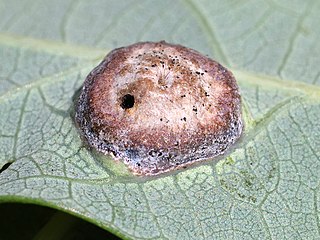
Callirhytis quercusfutilis, the oak wart gall wasp, is a species of gall wasp in the family Cynipidae.

Callirhytis quercusagrifoliae, commonly known as the bud gall wasp, is a species of cypnid wasp that induces galls on the flower buds of coast live oaks and interior live oaks. This wasp has been observed in California in North America.

Callirhytis serricornis, formerly Andricus serricornis, the kernel flower gall wasp, is a species of hymenopteran that produces galls on oak trees in California in North America. The wasp oviposits on coast live oak and interior live oak and induces a gall shaped roughly like a bottle or vase. The gall is brown in the first generation, and red and green in the second.

Callirhytis perfoveata, formerly Andricus perfoveata, the leaf ball gall wasp, is a species of hymenopteran that produces leaf galls on oak trees in California in North America. The wasp oviposits on coast live oak, interior live oak, and occasionally on California black oak, and induces what appears to be a roughly spherical gall embedded within the leaf. The gall is initially bright green and turns brown as it ages.
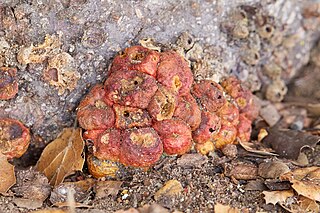
Callirhytis apicalis, formerly Andricus apicalis, the trunk gall wasp, is a species of hymenopteran that induces galls on the trunks or roots of black oak group trees in California in North America. Newly formed galls are red or yellow, turning brown as they age. This wasp is most often associated with Quercus agrifolia. This wasp is generally considered uncommon.

Callirhytis carmelensis, formerly Andricus carmelensis, the mottled acorn gall wasp, is a species of hymenopteran that induces galls on the acorns of coast live oaks and interior live oaks in California in North America. The purple or spotted green gall forms where the acorn attaches to the tree and often prevents normal development of the nut. The gall also produces a honeydew secretion that is attractive to other insects. This wasp is generally considered uncommon.

Callirhytis congregata, formerly Andricus congregata, the sausage flower gall wasp, is a species of hymenopteran that induces galls on the catkins of coast live oaks, interior live oaks, and canyon live oaks in California in North America. This wasp is considered locally common. William Harris Ashmead described Andricus congregatus as producing a gall like a "rugose, yellowish brown woody swelling, containing numerous cells growing apparently from the extreme tips of very slender twigs of Quercus chrysolepis, the gall appearing to have a long peduncle".
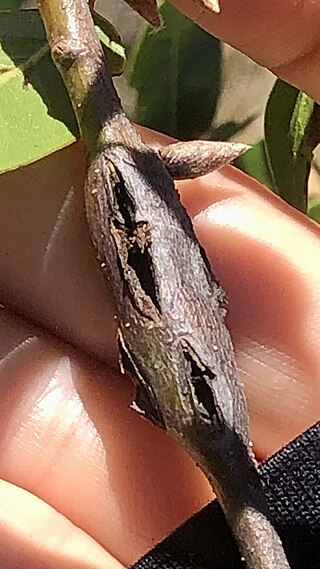
Callirhytis perdens, formerly Andricus perdens, the ruptured twig gall wasp, is a species of hymenopteran that induces integral stem galls on coast live oaks, interior live oaks, and canyon live oaks in California in North America. The wasps oviposit in the stem, and over time, the larval capsules are expelled from the lateral fissures onto the ground, where they either hatch in the leaf litter below the tree, or become fodder for grazing birds and other soil biota. This wasp is considered locally abundant.


















